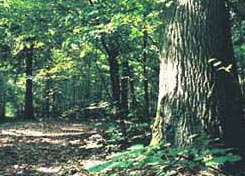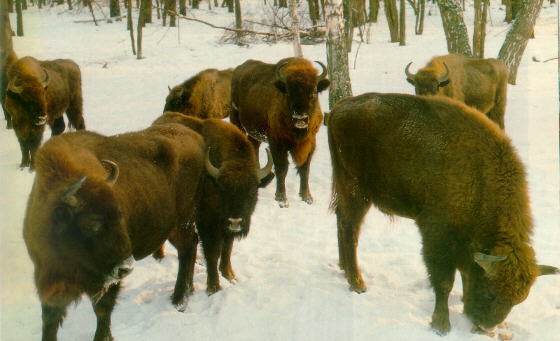
BELAVEZHSKAYA PUSCHA
Located part in Belarus and part in Poland Belavezhskaya Puscha is the Europe's last surviving primeval forest. And as such it is placed on the United Nations World's Heritage list. The harsh realities of a transition from socialist to capitalist economies are endangering Belavezha forest today on both Belarusian and Polish sides as it is being used for hunting and forestry.

The words "Belavezhskaya Puscha" are familiar to every Belarusian. The word Puscha is one of the most expressive and euphonious in the Belarusian language. The word's sounds make the listener imagine a primeval forest which has preserved its prehistoric nature. As for the name Belavezhskaya Puscha, it appeared in Lithuanian and Polish chronicles in 1409 and has lived till today. The forest acquired its name thanks to the white tower (Belaya Vezha) which was erected more than 700 years ago (between 1276 and 1288) near the small town of Kamianiec. The original name of the tower is Kamyaneckaya Vezha - after the name of the town. The tower ( "vezha" in Belarusian) had strategic military purpose - to watch the approach of enemy troops.
At that time the tower was surrounded by dense forest. Now only from the top of the tower can one see an immense space of forest. Nowadays Belaviezhskaja Puscha is what is left of the primeval forest which in 12th century stretched from the Baltic sea to the Buh river and from Odder to the Dnieper river.
The first mentions of Puscha appeared in 983. An archeological investigation showed that in prehistoric times bull, cave bear, north elk, and mammoth lived on the territory of today's Puscha. As for man, science is silent as to when he appeared in the Puscha. By some sources, only a tribe of Yacviahs lived here as mentioned in the Kievan chronicles. The origin of Yacviahs is unknown. In 983 Kievan Prince Uladzimir began to force Yacviahs out of Puscha. Lithuanian Prince Traiden in 1281 "succesfully" finished the extermination of the ancient tribe. The rest of Yacviahs were assimilated by Belarusians. On the other hand by other sources Yacviahs lived far North from Pushcha and never settled here. In 10th-13th centuries, Pushcha was home to Slavic tribes, and archeological evidence (graves, artifacts etc.) indicates mixed influences of the Western Slavs (Masovian type culture) and Eastern Slavs (Dregoviche type culture). The history of the region has been re-written many times to different political and ethnical tastes. And so instead of deciding which is true we leave you with both theories :)
The first attempt to profit from Puscha dates from the middle of the 16th century. During the reign of Polish King Sigizmund August, four iron producing plants were built on the territory of Puscha. At the same time collection of resin, distilling of tar, and burning of coal started. The industrial development of Puscha flourished during the reign of the last Polish King Stanislav August. Rivers flowing through Puscha were cleared and the floating of timber to Dancig began.
In 1795 after the division of Poland Belaviezhskaja Puscha found itself a part of the Russian empire. The empress the Katherine the Great distributed the Puscha among her servants who took part in the subjugation of the forest territory. Since then the ancient forest has suffered from both natural disasters and human activities. In May 1811 Puscha suffered from a conflagration which was extinguished only in the middle of October by rains. The fire caused the number of animals living in Puscha to decrease sharply. But not only the fire was the cause of the decrease in the number of animals. In 1812 the forest became one of the theaters of the martial operations of Napoleon. The French troops were followed by the Austrian troops of Schwartsenberg. All these troops needed food, which it found in Puscha. In the thirties the Puscha was often visited by boat builders from Petersburg who found in the forest very rich resources of timber. Three thousand people were involved in the cutting of the oaks and pines there. At the end of the forties of the last century the Puscha suffered another mass cutting. In 1864 the first twenty noble elks, which had been exterminated by 1705, were brought from Germany and released into the terrain of the Puscha. In 1888 the Russian tsar Nicolas II took Puscha's lands under his patronage. Word War I did not bypass the ancient forest. German invaders constructed 300 km of rail roads and in two years cut down and took to Germany 4.5 mln cubic meters of the best timber. Exploitation of the forest did not terminate after the war when Puscha was acquired by Poland. Every year more than a million cubic meters of timber were taken to England. In 1939, after the Soviets "liberated" Western Belarus, Puscha was declared a state reserve. The silence did not last long. World War II began and Puscha was again occupied by Germans. During the war the library and scientific archives of the forest were burnt down. After Puscha was cleared of Nazis, the forest resumed its reserve status. Many well known scientists came to study the natural heritage of the Puscha. In 1944 part of the reserve was given to neighboring Poland.
European Bison - Zoobr

In 1957 the reserve entered another stage when it was turned into a hunting reserve. Power keepers treated Puscha not as a natural heritage but as a place for rest and hunting. However, it is worth mentioning that the new status contributed to the improvement of the living and working conditions of the workers of the forest reserve. A hotel, school, museum, and administrative buildings were erected very quickly. At the same time governmental residence was built in the part of Puscha called Viskuli.
European Wild Horse - Tarpan

The World learnt about Viskuli in December, 1991 when the USSR ceased to exist. It is in Viskuli where the leaders of three Slavonic republics of the USSR were summoned to dissolve the Soviet Union. Belaviezhskaja Puscha proved its historical significance having become a noticeable point on the political map. The same year the hunting reserve was dissolved. Belaviezhskaja Puscha was declared a national park. The residence in Viskuli acquired the status of governmental residence of the Republic of Belarus.
On December 14, 1992 UNESCO included the ancient forest on the list of the World Heritage of Humankind. A year later UNESCO gave the Puscha the status of biosphere reserve. Thus Puscha entered a world system for surveying changes in the environment.
Belaviezhskaja Puscha gives strength to all of us. It carries the feeling of eternity, kindness and peace.
Other links to the information on Belavezha:
![]() Belavezhskaya Pushcha - 21st Century site
Belavezhskaya Pushcha - 21st Century site
![]() Frank Nature pages on Belavezha
Frank Nature pages on Belavezha
![]() Mammal
Research Institute Polish Academy of Sciences, Bialowieza, Poland.
Mammal
Research Institute Polish Academy of Sciences, Bialowieza, Poland.
![]() European Bison.
also here Zubry.com
European Bison.
also here Zubry.com
![]() European wild horse - Tarpan
European wild horse - Tarpan
![]() To the Belarusian Nature site
To the Belarusian Nature site
 This file is a part of the Virtual
Guide to Belarus - a collaborative project of Belarusian
scientists and professionals abroad. VG brings you the most extensive compilation
of the information about Belarus on the Web.
This file is a part of the Virtual
Guide to Belarus - a collaborative project of Belarusian
scientists and professionals abroad. VG brings you the most extensive compilation
of the information about Belarus on the Web.
Please send your comments to the authors of VG to
Belarus
History | Statehood | Culture | Law
and Politics | Cities | Nature and Geography |
©1994-04 VG to Belarus
Disclaimer